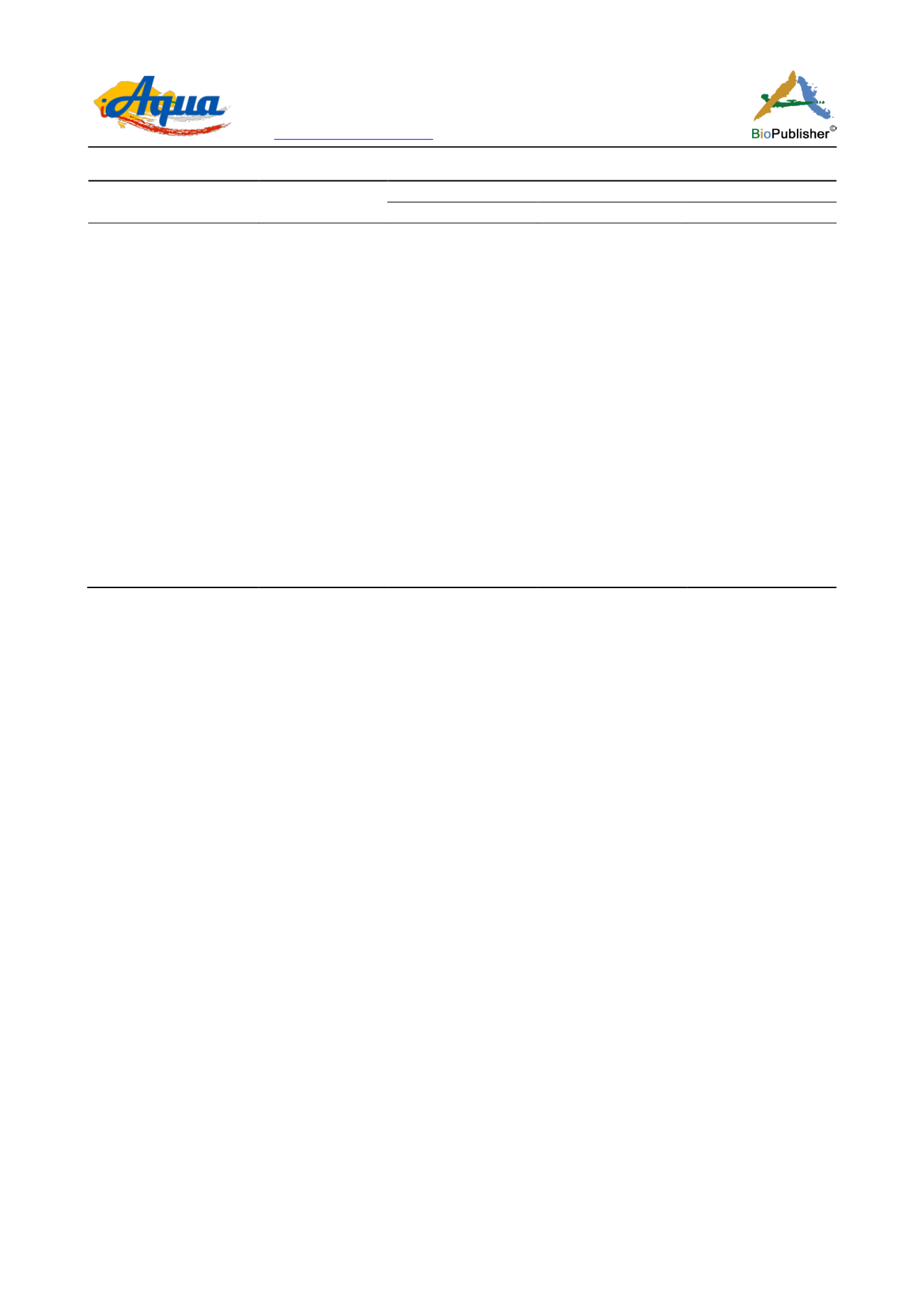
International Journal of Aquaculture, 2016, Vol.6, No.21, 1
-
9
5
Table 4 Digestive enzyme activity (Total activity ±S.E.) in the gut of common carp fed experimental diets
Pancreas
Intestinal segments
I
II
III
Amylase activity
T
0
0.71* ±0.02
a
2.36 ±0.40
d
0.59 ±0.06
b
0.52 ±0.02
b
T
1
0.75 ±0.03
a
1.56 ±0.20
c
0.57 ±0.08
b
0.29 ±0.01
a
T
2
0.89 ±0.07
b
1.40 ±0.08
c
0.59 ±0.03
b
1.23 ±0.06
c
T
3
0.82 ±0.03
b
1.06 ±0.04
b
0.71 ±0.02
c
0.59 ±0.09
b
T
4
1.04 ±0.05
c
0.74 ±0.04
a
0.27 ±0.05
a
0.53 ±0.04
b
Protease activity
T
0
35.23 ±0.56
a
98.71 ±0.52
a
98.71 ±0.43
b
79.35 ±0.80
a
T
1
85.55 ±0.45
b
156.78 ±0.46
c
119.03 ±0.60
d
124.65 ±0.62
c
T
2
86.70 ±0.34
b
130.65 ±0.42
b
92.26 ±0.81
b
165.48 ±0.76
d
T
3
107.87 ±0.22
c
99.55 ±0.31
a
107.43 ±0.12
c
92.90 ±0.52
b
T
4
125.03 ±0.78
d
164.90 ±0.61
c
72.97 ±0.0.53
a
76.77±0.46
a
Lipase activity
T
0
45.0 ±1.2
b
50.0 ±0.9
b
45.0 ±1.1
c
45.0 ±0.8
c
T
1
50.0 ±1.4
c
45.0 ±0.8
a
40.0 ±0.5
b
35.0 ±0.7
b
T
2
60.0 ±1.5
d
50.0 ±0.8
b
30.0 ±0.4
a
45.0 ±0.5
c
T
3
40.0 ±0.9
a
45.0 ±1.1
a
40.0 ±0.6
b
35.0 ±0.4
b
T
4
40.0 ±0.8
a
45.0 ±0.6
a
30.0 ±0.8
a
25.0 ±0.5
a
Note: *Enzyme units/g tissue
Values with different superscripts in the same column indicate significant (P≤0.05) difference
4 Discussion
The water quality parameters monitored were suitable for fish growth (Boyd, 1982), with no drastic variation
between treatments. Temperature ranged from 28 to 29.5ºC. Bhatnagar et al.
(2004) suggested that a temperature
range of 28-32ºC is ideal for tropical major carps, whereas Santhosh and Singh (2007) observed that the suitable
water temperature for carp culture is between 24 and 30 ºC. pH between 7 to 8.5 is considered suitable for
biological productivity. In general, an aquaculture pond should have a pH range between 6.5 and 9.0 (Wurts and
Durborow, 1992; Bhatnagar et al., 2004). pH varied from 7.0 to 8.4 in the present study. The dissolved oxygen
content was optimum in all the treatments (5.0 to 8.8 ppm). Dissolved oxygen affects growth, survival,
distribution, behaviour and physiology of aquatic organisms (Solis, 1988). According to Bhatnagar and Singh
(2010), DO level of > 5 ppm is essential to support good fish production. Oxygen depletion in water leads to poor
feeding, starvation, reduced growth and fish mortality (Bhatnagar and Garg, 2000). Free carbon dioxide was
detected only on a few days at low levels, the highest level recorded being 1.4 ppm. Santhosh and Singh (2007)
opined that for supporting good fish production, free carbon dioxide in water should be less than 5 mg/L.
Alkalinity of 42 to 70 ppm was recorded in this study. According to Wurts and Durborow (1992), alkalinity
between 75 to 200 mg/L, but not less than 20 mg/L is ideal in aquaculture.
The best growth of fish was recorded under 2 g G-Pro treatment, followed by 1 g; fish fed higher doses did not
differ from the control. Higher growth of fish fed G-Pro can be attributed to the feed additive, since all other
ingredients were common to the diets tested. Yeast and B-complex vitamins, the main constituents of G-Pro, must
have been responsible for the higher growth. Survival and net production were also the best in the treatment that
yielded the best growth. Dietary supplementation of commercial live yeast,
Saccharomyces cerevisiae
, improved
growth and feed utilization in Israeli carp (Noh et al., 1994) and Nile tilapia (Abdel-Tawwab et al., 2008). Studies
of Panigrahi et al. (2005) and Abo-State et al. (2009) revealed a positive effect of using viable microorganisms in
probiotic mixtures in fish diets. Dhanaraj et al. (2010) found significant improvement in growth performance and
gut microbial load in koi carp fed with 0.5% brewer’s yeast in the basal diet
.
Khalil et al. (2012) found improved
fish growth, feed intake and nutrient utilization, as well as fish carcass composition in tilapia fed yeast
incorporated diets. Heidarieh et al. (2013) reported increased feed intake, improved feed conversion ratio (FCR)


